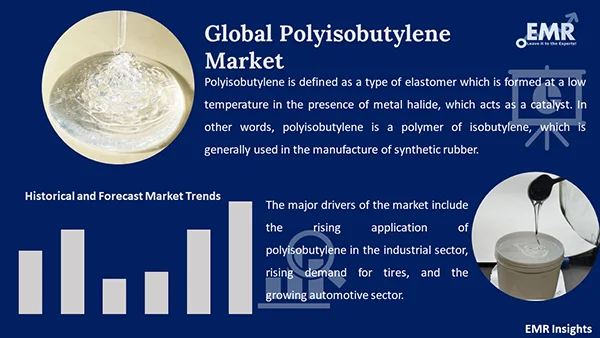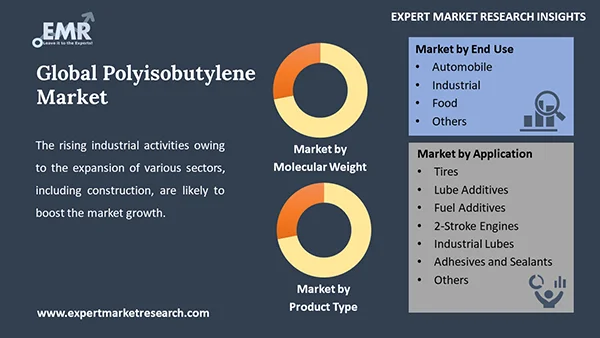
Consumer Insights
Uncover trends and behaviors shaping consumer choices today
Procurement Insights
Optimize your sourcing strategy with key market data
Industry Stats
Stay ahead with the latest trends and market analysis.
The global polyisobutylene market stood at a value of more than USD 3.24 Billion in 2025. The market is further expected to grow at a CAGR of 4.80% in the forecast period of 2026-2035 to attain a value of over USD 5.18 Billion by 2035.
Base Year
Historical Period
Forecast Period
Compound Annual Growth Rate
4.8%
Value in USD Billion
2026-2035
*this image is indicative*
| Global Polyisobutylene Market Report Summary | Description | Value |
| Base Year | USD Billion | 2025 |
| Historical Period | USD Billion | 2019-2025 |
| Forecast Period | USD Billion | 2026-2035 |
| Market Size 2025 | USD Billion | 3.24 |
| Market Size 2035 | USD Billion | 5.18 |
| CAGR 2019-2025 | Percentage | XX% |
| CAGR 2026-2035 | Percentage | 4.80% |
| CAGR 2026-2035 - Market by Region | Asia Pacific | 5.5% |
| CAGR 2026-2035 - Market by Country | China | 5.3% |
| CAGR 2026-2035 - Market by Country | Canada | 5.0% |
| CAGR 2026-2035 - Market by Molecular Weight | High | 5.4% |
| CAGR 2026-2035 - Market by Product Type | Highly Reactive PIB | 5.2% |
| Market Share by Country 2025 | India | 4.1% |
The highly reactive PIB segment, based on type, accounts for a significant share in the market owing to the high viscosity and the ability of this type of polyisobutylene to deliver excellent results in lubricant thickening. In addition to this, the high reactivity of PIB, which is attributed to the terminal location of the double bonds, allows it to react more quickly, resulting in efficient and fast production of derivatives. This makes it ideal for the production of dispersants and detergents. Furthermore, the favourable properties of HR PIB, which include high degree elongation, moisture resistance, and good adhesion properties to multiple substrates makes it suitable for the production of sealants. Hence, this segment is anticipated to grow at a significant rate in the forecast period.

Read more about this report - REQUEST FREE SAMPLE COPY IN PDF
The polyisobutylene industry in the Asia Pacific is driven by the expansion of large tube and tire manufacturing companies in the region owing to the thriving automotive sector in countries like India and China. In India, the increasing foreign direct investments (FDI) and the favourable government initiatives are likely to propel the demand for polyisobutylene in order to augment domestic manufacturing. The market in the region will further be aided by the rapid urbanisation and infrastructure development, which will generate the demand for polyisobutylene in various applications.
Polyisobutylene is defined as a type of elastomer which is formed at a low temperature in the presence of metal halide, which acts as a catalyst. In other words, polyisobutylene is a polymer of isobutylene, which is generally used in the manufacture of synthetic rubber.
Based on molecular weight, the market can be segmented into:
The major product types available in the market include:
The segmentation of the market, on the basis of end use, includes:
The significant applications of the product include:
Market Breakup by Region:

Read more about this report - REQUEST FREE SAMPLE COPY IN PDF
| CAGR 2026-2035 - Market by | Country |
| China | 5.3% |
| Canada | 5.0% |
| UK | 4.4% |
| Germany | 4.0% |
| Australia | 3.8% |
| USA | XX% |
| France | XX% |
| Italy | 3.4% |
| India | XX% |
| Saudi Arabia | XX% |
| Brazil | XX% |
| Mexico | XX% |
| Japan | 3.3% |
The global polyisobutylene industry is driven by the rising application of the product in the automobile industry. In emerging economies, the rising demand for commercial automobiles for the transportation purpose and the growing popularity of passenger vehicles owing to the rising disposable income and rising leisure activities are likely to generate a significant demand for polyisobutylene in the forecast period. Furthermore, the rising industrial activities owing to the expansion of various sectors, including construction, are likely to boost the market growth.
The report gives a detailed analysis of the following key players in the global polyisobutylene market, covering their competitive landscape, capacity, and latest developments like mergers, acquisitions, and investments, expansions of capacity, and plant turnarounds:
The comprehensive EMR report provides an in-depth assessment of the market based on the Porter's five forces model along with giving a SWOT analysis.




*While we strive to always give you current and accurate information, the numbers depicted on the website are indicative and may differ from the actual numbers in the main report. At Expert Market Research, we aim to bring you the latest insights and trends in the market. Using our analyses and forecasts, stakeholders can understand the market dynamics, navigate challenges, and capitalize on opportunities to make data-driven strategic decisions.*
Get in touch with us for a customized solution tailored to your unique requirements and save upto 35%!
In 2025, the global polyisobutylene market attained a value of more than USD 3.24 Billion.
The market is estimated to grow at a CAGR of 4.80% between 2026 and 2035.
The market is estimated to witness a healthy growth in the forecast period of 2026-2035 to reach over USD 5.18 Billion by 2035.
The major regions in the industry are North America, Latin America, the Middle East and Africa, Europe, and the Asia Pacific.
The major drivers of the market include the rising application of polyisobutylene in the industrial sector, rising demand for tires, and the growing automotive sector.
The rising investments by the manufacturers towards augmenting the supply chain management of the product to cater to its growing demand and the ongoing technological advancements are expected to be a key trend guiding the growth of the industry.
Low, medium, and high are the different segments based on molecular weight.
Conventional PIB and highly reactive PIB are the major product types of polyisobutylene.
Automobile, industrial, and food, among others are the significant end uses of the product.
Tires, lube additives, fuel additives, 2-stroke engines, industrial lubes, and adhesives and sealants, among others is the different applications in the polyisobutylene market.
The major players in the industry are BASF SE, Kothari Petrochemicals Limited, Ineos Group Ltd, Reliance Industries Limited., and The Lubrizol Corporation, among others.
Explore our key highlights of the report and gain a concise overview of key findings, trends, and actionable insights that will empower your strategic decisions.
| REPORT FEATURES | DETAILS |
| Base Year | 2025 |
| Historical Period | 2019-2025 |
| Forecast Period | 2026-2035 |
| Scope of the Report |
Historical and Forecast Trends, Industry Drivers and Constraints, Historical and Forecast Market Analysis by Segment:
|
| Breakup by Molecular Weight |
|
| Breakup by Product Type |
|
| Breakup by End Use |
|
| Breakup by Application |
|
| Breakup by Region |
|
| Market Dynamics |
|
| Competitive Landscape |
|
| Companies Covered |
|
| Report Price and Purchase Option | Explore our purchase options that are best suited to your resources and industry needs. |
| Delivery Format | Delivered as an attached PDF and Excel through email, with an option of receiving an editable PPT, according to the purchase option. |
Datasheet
One User
USD 2,499
USD 2,249
tax inclusive*
Single User License
One User
USD 3,999
USD 3,599
tax inclusive*
Five User License
Five User
USD 4,999
USD 4,249
tax inclusive*
Corporate License
Unlimited Users
USD 5,999
USD 5,099
tax inclusive*
*Please note that the prices mentioned below are starting prices for each bundle type. Kindly contact our team for further details.*
Flash Bundle
Small Business Bundle
Growth Bundle
Enterprise Bundle
*Please note that the prices mentioned below are starting prices for each bundle type. Kindly contact our team for further details.*
Flash Bundle
Number of Reports: 3
20%
tax inclusive*
Small Business Bundle
Number of Reports: 5
25%
tax inclusive*
Growth Bundle
Number of Reports: 8
30%
tax inclusive*
Enterprise Bundle
Number of Reports: 10
35%
tax inclusive*
How To Order

Select License Type
Choose the right license for your needs and access rights.

Click on ‘Buy Now’
Add the report to your cart with one click and proceed to register.

Select Mode of Payment
Choose a payment option for a secure checkout. You will be redirected accordingly.
Gain insights to stay ahead and seize opportunities.

Get insights & trends for a competitive edge.

Track prices with detailed trend reports.

Analyse trade data for supply chain insights.

Leverage cost reports for smart savings

Enhance supply chain with partnerships.

Connect For More Information
Our expert team of analysts will offer full support and resolve any queries regarding the report, before and after the purchase.
Our expert team of analysts will offer full support and resolve any queries regarding the report, before and after the purchase.
We employ meticulous research methods, blending advanced analytics and expert insights to deliver accurate, actionable industry intelligence, staying ahead of competitors.
Our skilled analysts offer unparalleled competitive advantage with detailed insights on current and emerging markets, ensuring your strategic edge.
We offer an in-depth yet simplified presentation of industry insights and analysis to meet your specific requirements effectively.
Share